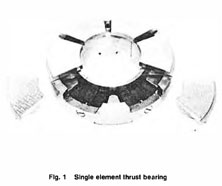

Literature and Knowledge Center
In-depth information on Kingsbury products, technologies and applications.
Effects of High-Operating Speeds on Tilting Pad Thrust Bearing Performance
J. W. Capitao, Design Engineer
Rotating Parts Systems Engineering, Mechanical Drive Turbine Products Dept.
General Electric Co., Fitchburg, Mass.
Assoc. Mem. ASME
R. S. Gregory, Manager, Research and Development
Kingsbury, Inc., Philadelphia, Pa.
Assoc. Mem. ASME
R. P. Whitford, Set Design Engineer, Product Engineering
General Electric Company, Mechanical Drive Turbine Products Dept.
Fitchburg, Mass.
A comparison of the high-speed performance characteristics of tilting-pad, self-equalizing
type thrust bearings through two independent full-scale programs is reported. This
paper presents experimental data on centrally pivoted, 6-pad, 267-mm (10 ½-in.) and
304-mm (12-in.) O.D. bearings operating at shaft speeds up to 14000 rpm and bearing
loads ranging up to 2.76 MPa (400 psi). Data presented demonstrate the effects of speed
and loading on bearing power loss and metal temperatures. Included is a discussion of
optimum oil supply flow rate based upon considerations of bearing pad temperatures
and power loss values.
Introduction
This paper presents the experimentally measured values of
bearing power loss and pad metal temperatures under variable
load, speed, and oil supply flow rate. Information of this nature,
especially in turbulent operation, has been very limited [1, 2, 3].1
The data presented have been obtained from two completely independent
test programs, which were developed on two dissimilar
test machines. When compared, the overall bearing performance is
consistent. This paper is intended to present new test data as a
contribution to the better understanding of the phenomenon of
turbulence in fluid film bearings.
 The bearings under study were the conventional 6-pad, steel-backed,
centrally pivoted, self-equalizing, 267-mm (10 ½-in.) and
304-mm ( 12-in.) O.D. tilting pad type illustrated in Fig. 1. The experimental
data reported on the 267-mm (10 ½-in.) and the 304-
mm (12-in.) bearings were collected on two independent test facilities.
The bearings under study were the conventional 6-pad, steel-backed,
centrally pivoted, self-equalizing, 267-mm (10 ½-in.) and
304-mm ( 12-in.) O.D. tilting pad type illustrated in Fig. 1. The experimental
data reported on the 267-mm (10 ½-in.) and the 304-
mm (12-in.) bearings were collected on two independent test facilities.
The investigations studied the effects of external parameters
such as applied load, shaft speed, and oil flow rate on the performance
of tilting pad thrust bearings operating under simulated
field conditions. Table 1 indicates the bearing sizes, areas, shaft speeds and applied loads. Bearing performance was evaluated by
an analysis of pad metal temperatures and bearing power loss as
influenced by variation of external parameters. A petroleum-based,
light turbine oil with a viscosity of 32 µm2/S at 38°C (150
SUS at 100°F) was used as a lubricant in both test programs.
The data herein represent only a portion of testing so far undertaken
in the two research programs. A previous paper [2] has reported
preliminary results on the 267-mm (10 ½-in.) bearing, and
an additional paper [4] has been submitted relating to 432-mm
(17-in.) and 381-mm (15-in.) bearings.
Read full PDF

